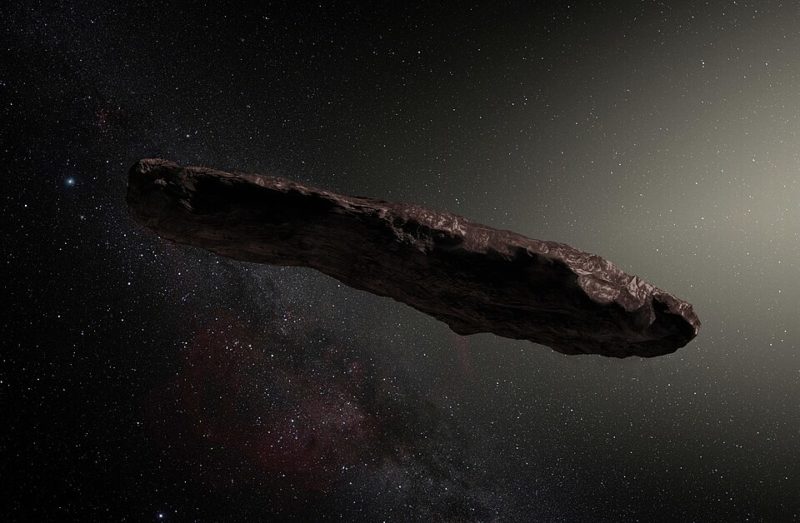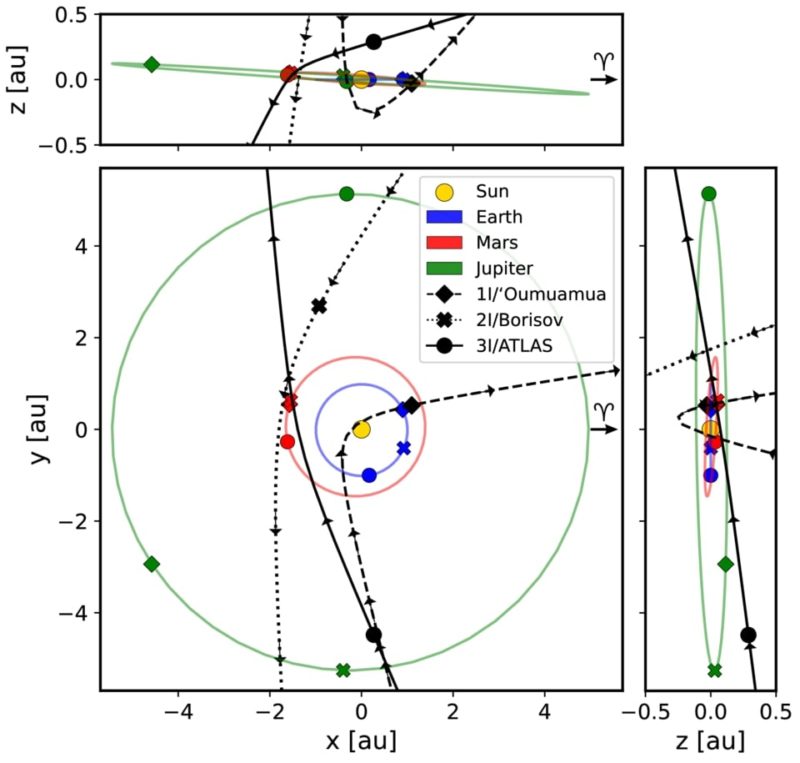1I/ʻOumuamua: the First Known Interstellar Object

1I/ʻOumuamua is an interstellar object that passed through the Solar System. Discovered on 19 October 2017 by Pan-STARRS, it traveled a hyperbolic trajectory with an eccentricity of around 1.2 and a maximum velocity of approximately 87 km per second with respect to the Sun. Its extreme aspect ratio, non-gravitational acceleration, and lack of visible coma ignited quite the controversy.
What Was 1I/ʻOumuamua?
The first known interstellar asteroid, observed in our solar system by Pan-STARRS in Hawaii, 1I/ʻOumuamua’s elongated shape and trajectory challenged existing theories about how planetary systems create and expel small bodies.
The Discovery
1I/ʻOumuamua was discovered on October 19, 2017, by Pan‑STARRS at Haleakalā Observatory in Hawaii during their normal near‑Earth object sweeps. Its sky-plane motion identified it as odd within hours.
Key interstellar markers stood out: a distinctly hyperbolic orbit with an eccentricity greater than 1, an excess speed at infinity, and a Sun-relative velocity near 87 kilometers per second.
Follow-up sprang into action. ESO’s VLT, Hubble Space Telescope, and many national facilities followed with photometry and astrometry. The opportunity to observe it was short-lived. It faded fast and hurtled away.
The Name
1I/ʻOumuamua, the first interstellar asteroid, is Hawaiian for “scout” or “messenger,” chosen to honor the culture of its discovery location while representing a unique interstellar visitor. The IAU designated it 1I/‘Oumuamua, indicating its status as the first interstellar object.
The Trajectory
Its outbound orbit is hyperbolic, marking it as a unique interstellar visitor that is unbound and originated beyond the solar system. Approaching close to the direction of Vega in Lyra, within roughly 6 degrees of the solar apex, it departed toward Pegasus. The trail didn’t match any known comet families or asteroid groups, and its high eccentricity and surplus speed distinguished it from typical solar system objects.
The Anomaly
It tumbled with non-principal-axis spin and experienced non-gravitational acceleration, resembling an elongated interstellar asteroid. No dust coma or tail was observed, so traditional outgassing appeared to be minimal. Gravity and solar radiation pressure alone weren’t enough for this unique interstellar visitor. Concepts spanned from a flat, weird geometry to hydrogen outgassing.

Scientific Observations
Global campaigns brought Hubble, Gemini South, ESO’s VLT, and other large telescopes to bear days after the October 19, 2017, Hawai‘i discovery of the first interstellar asteroid. Teams secured broadband photometry, spectra, and precise astrometry to map the light curve, color, shape, and hyperbolic motion of this unique interstellar visitor.
Its Shape
Observations point to an extreme elongation, with an aspect ratio possibly near ten to one, unlike any known comet or asteroid of similar size (up to approximately 400 meters long). Light-curve amplitudes greater than two magnitudes under phase-angle changes corroborate an extremely high axis ratio, but surface albedo uniformity complicates inversion.
Competing models, cigar-like, pancake-like, and thin, flat “sheet-like,” fit portions of the photometry after tumbling is factored in. Shape inference is bound up with spin-state solutions and scattering laws. Minor adjustments tip the preferred model.
- Proposed shape: Prolate “cigar” Evidence: Large amplitude light curve, specular-like glints plausible under elongated geometry, consistent with earlier asteroid analogs.
- Proposed shape: Oblate “pancake” Evidence: Phase-angle dependence fits better under Lambertian and roughness. It explains non-gravitational effects with high area-to-mass.
- Proposed shape: Flat sheet-like. Evidence: Extreme area-to-mass ratio scenarios match rapid brightness swings during complex tumble.
Its Color
1I/ʻOumuamua exhibited a red color, similar to some objects in the outer solar system and interstellar dust. This suggests extended cosmic-ray exposure and space weathering.
Albedo variation across the surface appeared minor, so the face we observed was relatively homogeneous. Color information assisted in rejecting the possibility of pure metal or clean ice, and a mixed, processed surface is more probable.
Its Motion
Astrometry uncovered a small but genuine non-gravitational acceleration unaccounted for by typical outgassing or asteroid mechanics. The body tumbled in a non-principal-axis rotation, probably from previous collisions or torque.
Inbound and outbound speeds around 26.33 km/s relative to the Sun validated an interstellar origin and escape trajectory. Track-backs indicate previous fly-bys by a number of stars, nearest to HIP 3757 approximately 1 million years ago. It crossed Mars’s orbit around November 1, 2017, Jupiter’s in May 2018, and beyond Saturn by January 2019, consistent with a swift departure.
Vega alignment stories were coincidence; Vega was somewhere else approximately 300,000 years ago. There is no good reason to believe that it reversed course and re-entered; it shows solutions that indicate it is leaving the solar system.
Competing Theories
Rival theories attempt to explain 1I/ʻOumuamua’s unusual form, its classification as the first interstellar asteroid, and the absence of a dust coma, leaving no one framework sealing the deal.
Natural Origin
Several researchers see 1I/ʻOumuamua as a planetesimal chunk flung out from another solar system in the chaotic early days of planet formation. Its hyperbolic trajectory and velocity are consistent with dynamical simulations for interstellar asteroids ejected by massive planets.
Backtracing lists multiple past passes near stars, with the nearest pass near HIP 3757 about 1 Myr ago. Its approach direction roughly matches the area around Vega, a bright star in the northern constellation. The star was situated somewhere different at the time, so the connection is tenuous.
There are a few variants regarding this unique interstellar visitor. One suggests a nitrogen-ice shard from a Pluto-like exoplanet. Bodies like this could sublimate invisibly, sculpting the acceleration and leaving behind no detectable dust. Another posits it as a new class of interstellar comet or asteroid with atypical chemistry and porosity.
Some say it was a slightly active comet, not a stony asteroid. Critics observe that outgassing torques on such an elongated interstellar asteroid would quickly spin it up and probably tear it to pieces, which was not observed. The lack of a coma stresses normal comet physics, though low dust production or small, volatile-driven jets are still plausible.
Artificial Origin
A minority opinion offers a synthetic probe into the fascinating discovery of the first interstellar asteroid. Its giant cigar-to-pancake aspect ratio, tumbling state, and small yet persistent acceleration brought to mind concepts of a thin solar-sail-like object optimized for photon pressure.
Proponents like Harvard’s Avi Loeb argue that the anomalies deserve careful attention due to selection effects in short detections, especially in the context of astronomical research on interstellar objects.
Counterarguments are powerful. There are no radio signals, beacons, or engineered spectral lines. The acceleration scales better with thermally driven outgassing than with solar radiation pressure for reasonable area-to-mass ratios. Absent direct tech signatures, artificial control is conjectural.
A Cosmic Messenger
The discovery of 1I/ʻOumuamua, the first interstellar asteroid, compelled a hard consideration of our place in a galaxy that’s active, not peaceful. A one-off sight like this can reset priorities, influencing how we search for interstellar objects and what we expect to find.
Shifting Paradigms
Its discovery demonstrated that interstellar asteroids are not mythical phantoms but tangible tourists. An object zipping along at 26.33 kilometers per second relative to the Sun. This is well within the grasp of current astronomical research.
Theoretical models of planetary system formation now allow plenty of room for violent ejections. Systems may shed vast debris into interstellar space, including shards of nitrogen ice like Pluto’s crust, remnants of disintegrated rogue comets, and even fractured exo-planetary crusts. Those routes could account for its dimensions, color, and surface chemistry.
The Milky Way seems more like a freeway. Rogue planets, cold comets, and weird asteroids wander through. 1I/ʻOumuamua even skimmed near several stars, most closely to HIP 3757 roughly a million years ago, suggesting complicated stellar thoroughfares.
Future Interstellar Visitors
More interstellar asteroids are probably inbound. 1I/ʻOumuamua revealed a population far greater unseen. Its track, some 6 degrees from the solar apex and approximately from Vega in Lyra, suits a chance field source. Low hundreds of meters in size and harsh ablation, probably melting more than 90 percent of itself before we encountered it, suggest delicate composition sculpted by extended cosmic rays. This fascinating discovery leads to science we could do only with quick alerts and swift follow-up.
Improved surveys will increase the catch rate. The Vera C. Rubin Observatory’s LSST will sweep the sky every few nights with deep limiting magnitudes and difference imaging that flags fast movers. Pan-STARRS updates, Zwicky Transient Facility, and future space sensors will broaden time coverage and cut down false alarms.
Machine learning filters trained on streaks, parallax, and non-gravitational accelerations ought to catch strange trajectories early. Even so, routes are difficult to predict. Among other reasons, small forces such as outgassing, radiation pressure, and small gravity kicks add up quickly at high incoming velocities, so orbit solutions require dense, multi-wavelength astrometry and immediate radar if the object is within range.
We need waiting starships for the next interstellar object. Flybys such as ESA’s Comet Interceptor can loiter at Sun–Earth L2, then dash to a fresh discovery. A modular payload—visible and infrared imagers, ultraviolet spectrograph, mass spectrometer, dust analyzer—could measure volatile mix, grain size, isotopes, and surface weathering.
For deeper study, fast propulsion options matter: solar Oberth burns with high thrust stages, near-term solar electric primes, and longer horizon laser electric or laser sail systems for kilometers per second class sprints. They might sample pristine material, provide new constraints on planetary system formation in other systems, test how cosmic rays alter ices and organics, and, with any luck, explore hints related to prebiotic chemistry.
Conclusion
1I/ʻOumuamua delivered a piercing alarm. A rapid, peculiar, tiny object sliced through the Sun’s neighborhood and challenged our simulations. The data showed a non-gravitational push, no dust, no coma, high albedo, and a spin that did not sit still. Each model matched a segment. None suited all.
To get beyond speculation, we need more eyes on the sky and speedier follow-ups. LSST can alert the next one in advance. A nimble probe, a tiny solar sail with a cold-gas trim kit, could instead match track and scan in situ. Think of spectra, radar ping, and dust sniff all in a single swoop.
To stay in the loop, subscribe to our space brief or share your take with a comment.
Frequently Asked Questions
What is 1I/ʻOumuamua?
1I/ʻOumuamua, the first interstellar asteroid identified in 2017 by Pan-STARRS in Hawaii, swiftly traversed the inner Solar System, suggesting it is a unique interstellar visitor originating beyond our Solar System.
Why is 1I/ʻOumuamua’s shape debated?
The results indicated something either extremely elongated, resembling an interstellar asteroid, or a flattened ‘pancake’ shape. It was too small and too far away for direct imaging, which complicated astronomical research and the understanding of its true form.
Did 1I/ʻOumuamua show signs of alien technology?
There is no evidence to confirm that this elongated interstellar asteroid exhibits non-gravitational acceleration, which is likely due to natural outgassing or hydrogen sublimation, aligning with typical comet behavior.
What caused 1I/ʻOumuamua’s odd acceleration?
The top hypothesis for the elongated interstellar asteroid involves feeble outgassing of volatile ices creating minor thrust, while another model suggests hydrogen outgassing from cosmic-ray processing, both lacking dust or observable coma.
How was 1I/ʻOumuamua detected?
Pan-STARRS1 discovered the unique interstellar visitor due to its rapid movement and unconventional path. Follow-up observations from worldwide observatories, including the Hawaii telescope, honed its orbit and confirmed its interstellar origin through its hyperbolic trajectory and excess velocity.
Can future missions study such objects up close?
Possibly. Ideas feature fast-acting spacecraft or interceptor missions staged for liftoff. It’s important to catch the interstellar asteroid early. With timely tracking, a flyby could capture spectra, imagery, and dust data to settle current open questions.
Would you like to receive similar articles by email?





